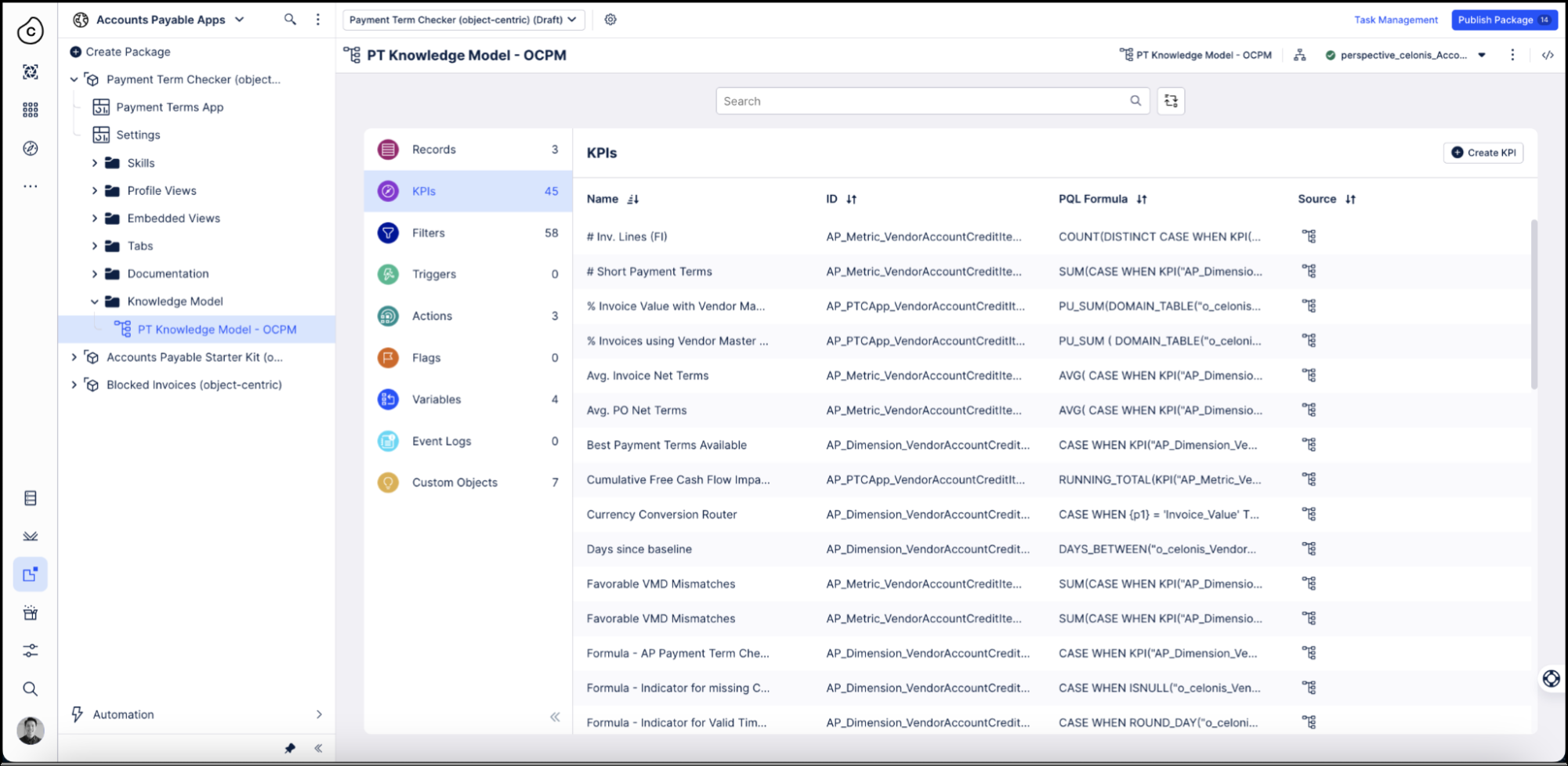Validating KPIs for the object-centric Payment Term Checker app
Work with the Settings view to change the default parameters for the Payment Term Checker app. We explain how we calculate each KPI, and what parameters the app uses by default. You can change their values to align with how things are done in your organization. The Settings view is the best way to adjust the KPIs in the Payment Term Checker app’s Knowledge Model. If you’ve worked through your use case there but something is still not the way you want it, you can make further adjustments directly in the Knowledge Model in Studio.
The main Knowledge Model for the Payment Term Checker app is called “Payment Term Checker (OCPM)”, and it’s in the Knowledge Model folder. You’ll need Analyst permissions on Studio and the Knowledge Model to update it. Each KPI contains a PQL (Process Query Language) formula which you can change in our editor to change how the KPI behaves. Your changes are applied when you publish a new version of the app.
The Knowledge Model also includes calculated attributes that contain the business logic to classify and provide metadata about objects. You can use them in PQL queries as if they were another column in the database table for the object type. They appear in the Knowledge Model as attributes of relevant records. If you make any edits to view components that involve the calculated attributes from the Knowledge Model, we’ll automatically update the calculated attributes in the Knowledge Model to match your edits. You can also adjust them directly in the Knowledge Model before or after editing the views.
Calculated attributes and PQL formulas might be reused in the calculations for several KPIs across the Knowledge Model. If you change the business logic in one location and save your change, all of the KPIs that reuse the calculated attribute or PQL formula will reflect your changes.

Here’s how to work with the KPIs and calculated attributes in the app’s Knowledge Model. If you need training, check out the training track “Build Knowledge Models and Views” on the Celonis Academy.
In the Celonis navigation menu, select Studio.
In the Studio overview, find the Payment Term Checker app in the space where you installed it, and click its tile.
Select the Knowledge Model from the app navigation.
Select the KPIs section of the Knowledge Model to work with KPIs, or the Records section to work with calculated attributes.
You can sort and search the KPIs using their name or ID. The table at the end of this topic lists the most important calculated attributes for the Payment Term Checker, with the records where you can find them and the use cases they apply to.
To see and edit the full PQL formula and other settings for a KPI, click its row to open an editor. The editor automatically validates any changes that you make in the PQL formula.
If you want a fuller-featured PQL editor that lets you select from the tables and columns in your data, click on the pen icon next to the PQL formula.
If you need to disable a KPI or formula, click the three vertical dots at the top of the editor, and select Disable Scope, then click Disable to confirm. When you do this, the object can't be accessed or used anywhere in the package, including by other apps that depend on it.
When you’ve made changes to the KPIs and calculated attributes, use the Publish button at the top of the screen in your Studio space to publish a new version of the app.
Here are the most important calculated attributes for the Payment Term Checker app:
Calculated Attribute name | Attribute ID | Record ID | Use cases |
|---|---|---|---|
Inv. Net Terms | InvoiceNetTerms | O_CELONIS_VENDORACCOUNTCREDITITEM | Payment Term Mismatches |
VMD Net Terms | VmdNetTerms | O_CELONIS_VENDORACCOUNTCREDITITEM | Payment Term Mismatches |
PO Net Terms | PoNetTerms | O_CELONIS_VENDORACCOUNTCREDITITEM | Payment Term Mismatches |
Best alternative Payment Term | BestAlternativeTerms | O_CELONIS_VENDORACCOUNTCREDITITEM | Payment Term Mismatches |
Greatest Payment Term available | BestAvailableNetTerms | O_CELONIS_VENDORACCOUNTCREDITITEM | Payment Term Mismatches |
Inv./PO Mismatch | PoInvoicePaymentTermsMismatchClassification | O_CELONIS_VENDORACCOUNTCREDITITEM | Payment Term Mismatches |
Inv./Vendor Mismatch | VmdInvoicePaymentTermsMismatchClassification | O_CELONIS_VENDORACCOUNTCREDITITEM | Payment Term Mismatches |
Inv./Vendor or PO Mismatch | AnyInvoicePaymentTermsMismatchClassification | O_CELONIS_VENDORACCOUNTCREDITITEM | Payment Term Mismatches |
Harmonization leads to better net term | HarmonizationLeadsToBetterTerms | O_CELONIS_VENDORACCOUNTCREDITITEM | Payment Term Harmonization |
Document has Short Payment Terms | HasShortPaymentTerms | O_CELONIS_VENDORACCOUNTCREDITITEM | Short Payment Terms |
Document has only Short Payment Terms | HasOnlyShortPaymentTerms | O_CELONIS_VENDORACCOUNTCREDITITEM | Short Payment Terms |
Document has PO relation | HasPoRelation | O_CELONIS_VENDORACCOUNTCREDITITEM | Generic |
Payment Terms decreased | HasPaymentTermDecrease | O_CELONIS_VENDORACCOUNTCREDITITEM | Generic |
Payment Terms increased | HasPaymentTermIncrease | O_CELONIS_VENDORACCOUNTCREDITITEM | Generic |
Cleared (after value tracking start within the last year) | IsClearedWithinValueTrackingPeriod | O_CELONIS_VENDORACCOUNTCREDITITEM | Generic |
Payment Behavior | PaymentBehavior | O_CELONIS_VENDORACCOUNTCREDITITEM | Generic |
Mismatch: Open, realizable FCF | ValueFramingMismatchesOpenRealizable | O_CELONIS_VENDORACCOUNTCREDITITEM | Value Framing: Mismatches |
Mismatch: Cleared, missed FCF | ValueFramingMismatchesClearedMissed | O_CELONIS_VENDORACCOUNTCREDITITEM | Value Framing: Mismatches |
Short Terms: Open, realizable FCF | ValueFramingShortTermOpenRealizable | O_CELONIS_VENDORACCOUNTCREDITITEM | Value Framing: Short Terms |
Short Terms: Cleared, missed FCF | ValueFramingShortTermClearedMissed | O_CELONIS_VENDORACCOUNTCREDITITEM | Value Framing: Short Terms |
Term Harmonization: Open, realizable FCF | ValueFramingShortTermHarmonizationBestVmdTermAppliedOpenRealizable | O_CELONIS_VENDORACCOUNTCREDITITEM | Value Framing: Harmonization |
Term Harmonization: Cleared, missed FCF | ValueFramingShortTermHarmonizationBestVmdTermAppliedClearedMissed | O_CELONIS_VENDORACCOUNTCREDITITEM | Value Framing: Harmonization |
Pending FCF impact | ValueTrackingMismatchesPendingFCFOpportunities | O_CELONIS_VENDORACCOUNTCREDITITEM | Value Realized: Mismatches |
Missed FCF impact | ValueTrackingMismatchesMissedFCFOpportunities | O_CELONIS_VENDORACCOUNTCREDITITEM | Value Realized: Mismatches |
Realized FCF impact | ValueTrackingMismatchesRealizedFCFOpportunities | O_CELONIS_VENDORACCOUNTCREDITITEM | Value Realized: Mismatches |
Rejected FCF impact | ValueTrackingMismatchesRejectedFCFOpportunities | O_CELONIS_VENDORACCOUNTCREDITITEM | Value Realized: Mismatches |